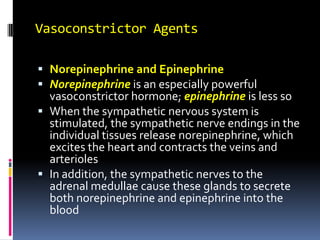
Lec60
- 1. Vasoconstrictor Agents Norepinephrine and Epinephrine Norepinephrine is an especially powerful vasoconstrictor hormone; epinephrine is less so When the sympathetic nervous system is stimulated, the sympathetic nerve endings in the individual tissues release norepinephrine, which excites the heart and contracts the veins and arterioles In addition, the sympathetic nerves to the adrenal medullae cause these glands to secrete both norepinephrine and epinephrine into the blood
- 2. Angiotensin II Angiotensin II is powerful vasoconstrictor substance The effect of angiotensin II is to constrict powerfully the small arterioles and decreases the blood flow Angiotensin II increases the total peripheral resistance, thereby increasing the arterial pressure
- 3. Vasopressin Vasopressin, also called antidiuretic hormone, one of the body's most potent vascular constrictor substances The concentration of circulating blood vasopressin after severe hemorrhage can rise high enough to increase the arterial pressure In many instances this canbringthe arterial pressure almost back up to normal
- 4. Other chemical influences on blood flow Histamine Most of the histamine is derived from mast cells in the damaged tissues Histamine has a powerful vasodilator Has the ability to increase greatly capillary porosity, allowing leakage of both fluid and plasma protein into the tissues
- 5. Bradykinin Bradykinin causes both powerful arteriolar dilation and increased capillary permeability Bradykinin play special roles in regulating blood flow and capillary leakage of fluids in inflamed tissues
- 6. Vascular Control by Ions and Other Chemical Factors An increase in calcium ion concentration causes vasoconstriction An increase in potassium ion concentration causes vasodilation An increase in magnesium ion concentration causes powerful vasodilation
- 7. An increase in hydrogen ion concentration causes dilation of the arterioles An increase in carbon dioxide concentration causes moderate vasodilation in most tissues, but marked vasodilation in the brain Vascular Control by Ions and Other Chemical Factors
- 8. Pharmacologic Stimuli that Cause Contraction or Relaxation of Vascular Smooth Muscle Vasoconstrictors Norepinephrine and epinephrine Endothelin Angiotensin II Vasopressin Calcium Vasodilator agents Histamine Adenosine Nitric Oxide (NO) Carbon Dioxide Potassium Magnesium Hydrogen Ion Prostaglandins Bradykinin
- 9. Distribution of Blood in the Body Organs
- 10. Flow rate in muscle Skeletal muscle constitute 40 – 45% body weight 5 ml/min/100 g to 80-100 ml/min/100 g Intermittent as a result of contraction of muscle Exercise opens capillaries
- 11. Control of blood flow through the skeletal muscle Local regulation- decrease oxygen in muscle greatly enhance flow During muscle activity, muscle uses oxygen thus decreasing oxygen in the tissue fluid Vasodilator – adenosine, potassium ions, carbon dioxide
- 12. Nervous control of muscle blood flow Skeletal muscles are provided with sympathetic vasoconstrictor nerves Sympathetic vasoconstrictor secrete norepinephrine in their nerve ending (important during shock and stress) Epinephrine – secreted by adrenal medullae gives vasodilator effect during exercise
- 13. Total Body Circulatory Readjustments During Exercise Three major effects occur during exercise (1) mass discharge of the sympathetic nervous system throughout the body (2) increase in arterial pressure (3) increase in cardiac output
- 14. Effects of Mass Sympathetic Discharge Three major circulatory effects result The heart is stimulated to greatly increased heart rate and increased pumping strength as a result of the sympathetic drive to the heart plus release of the heart from normal parasympathetic inhibition
- 15. Effects of Mass Sympathetic Discharge Most of the arterioles of the peripheral circulation are strongly contracted, except for the arterioles in the active muscles, which are strongly vasodilated by the local vasodilator Two of the peripheral circulatory systems, the coronary and cerebral systems, are spared this vasoconstrictor effect
- 16. The muscle walls of the veins are contracted powerfully, which greatly increases the mean systemic filling pressure This is one of the most important factors in promoting increase in venous return of blood to the heart and, therefore, in increasing the cardiac output Effects of Mass Sympathetic Discharge
- 17. Effect of Arterial Pressure Rise Increases force to drive blood (by 30%) Dilates vessels, decreasing resistance (can double flow rate)
- 18. Local vs Whole Body Exercise Local (e.g. lifting weight): Mainly vasoconstriction – high increase in BP (up to 170 mm Hg). Whole body (e.g. running): vasodilation in a large mass of muscles leads to more slight increase in BP (maybe 20-40 mm Hg).
- 19. Effects of Exercise on Muscle Circulation Increased heart rate & pumping strength Aterioles constricted in most of periphery (but not in coronary and cerebral systems). Active muscle arterioles dilated Vein muscle walls constricted (increased filling pressure, hence, increased venous return).
- 20. 12-15
- 21. Normal Coronary Blood Flow The resting coronary blood flow in the human being averages about 225 ml/min, which is about 4 to 5 per cent of the total cardiac output Coronary circulation is the functional blood supply to the heart muscle itself Collateral routes ensure blood delivery to heart even if major vessels are occluded
- 22. Coronary Circulation Left coronary artery supplies the anterior and left lateral of the left ventricle Right coronary artery supplies most of the right ventricle and posterior part of the left ventricle in 80 to 90% of the people
- 23. Coronary Circulation: Venous Supply Most of the coronary venous blood from the left ventricular muscle return to the right atrium by coronary sinus From the right ventricular muscle return through small anterior cardiac veins Very small amount of coronary venous blood flows back into the heart through thebesian veins
- 24. Phasic changes in coronary blood flow during systole and diastole
- 25. Left coronary blood flow Right coronary blood flow
